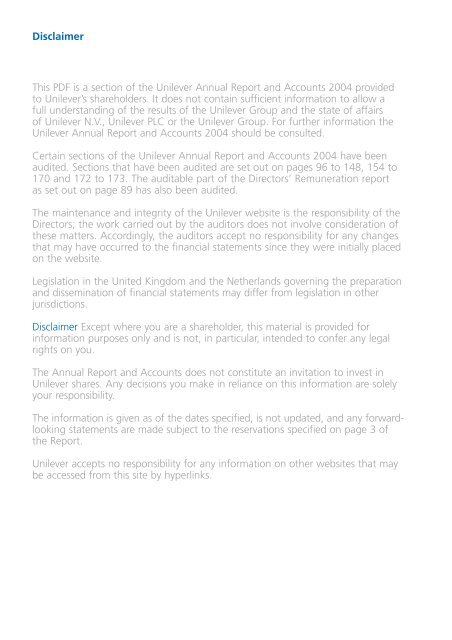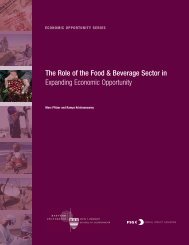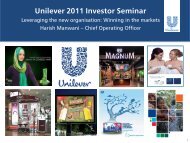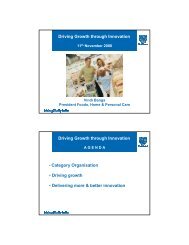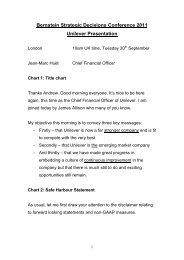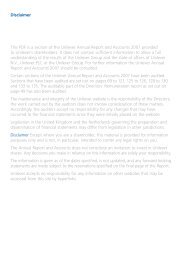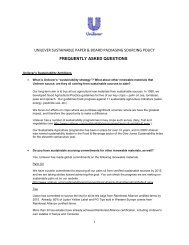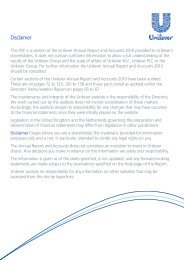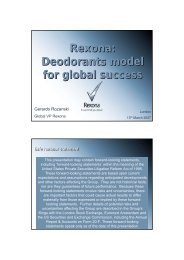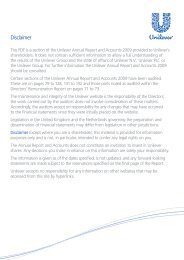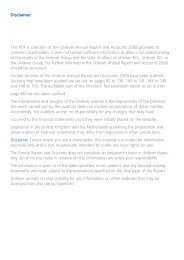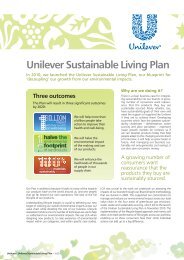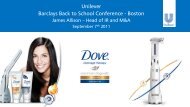Unilever Annual Report and Accounts 2004
Unilever Annual Report and Accounts 2004
Unilever Annual Report and Accounts 2004
Create successful ePaper yourself
Turn your PDF publications into a flip-book with our unique Google optimized e-Paper software.
Disclaimer<br />
This PDF is a section of the <strong>Unilever</strong> <strong>Annual</strong> <strong>Report</strong> <strong>and</strong> <strong>Accounts</strong> <strong>2004</strong> provided<br />
to <strong>Unilever</strong>’s shareholders. It does not contain sufficient information to allow a<br />
full underst<strong>and</strong>ing of the results of the <strong>Unilever</strong> Group <strong>and</strong> the state of affairs<br />
of <strong>Unilever</strong> N.V., <strong>Unilever</strong> PLC or the <strong>Unilever</strong> Group. For further information the<br />
<strong>Unilever</strong> <strong>Annual</strong> <strong>Report</strong> <strong>and</strong> <strong>Accounts</strong> <strong>2004</strong> should be consulted.<br />
Certain sections of the <strong>Unilever</strong> <strong>Annual</strong> <strong>Report</strong> <strong>and</strong> <strong>Accounts</strong> <strong>2004</strong> have been<br />
audited. Sections that have been audited are set out on pages 96 to 148, 154 to<br />
170 <strong>and</strong> 172 to 173. The auditable part of the Directors’ Remuneration report<br />
as set out on page 89 has also been audited.<br />
The maintenance <strong>and</strong> integrity of the <strong>Unilever</strong> website is the responsibility of the<br />
Directors; the work carried out by the auditors does not involve consideration of<br />
these matters. Accordingly, the auditors accept no responsibility for any changes<br />
that may have occurred to the financial statements since they were initially placed<br />
on the website.<br />
Legislation in the United Kingdom <strong>and</strong> the Netherl<strong>and</strong>s governing the preparation<br />
<strong>and</strong> dissemination of financial statements may differ from legislation in other<br />
jurisdictions.<br />
Disclaimer Except where you are a shareholder, this material is provided for<br />
information purposes only <strong>and</strong> is not, in particular, intended to confer any legal<br />
rights on you.<br />
The <strong>Annual</strong> <strong>Report</strong> <strong>and</strong> <strong>Accounts</strong> does not constitute an invitation to invest in<br />
<strong>Unilever</strong> shares. Any decisions you make in reliance on this information are solely<br />
your responsibility.<br />
The information is given as of the dates specified, is not updated, <strong>and</strong> any forwardlooking<br />
statements are made subject to the reservations specified on page 3 of<br />
the <strong>Report</strong>.<br />
<strong>Unilever</strong> accepts no responsibility for any information on other websites that may<br />
be accessed from this site by hyperlinks.
Financial review<br />
Basis of reporting <strong>and</strong> discussion<br />
Our accounting policies are based on United Kingdom generally<br />
accepted accounting principles (GAAP) <strong>and</strong> UK <strong>and</strong> Netherl<strong>and</strong>s<br />
law. These differ in certain respects from United States GAAP. The<br />
principal differences are described on pages 155 to 159. We have<br />
shown reconciliations to net income <strong>and</strong> capital <strong>and</strong> reserves<br />
under US GAAP on pages 154 <strong>and</strong> 155.<br />
For definitions of key ratios referred to in this review please refer<br />
to page 149.<br />
<strong>Report</strong>ing currency <strong>and</strong> exchange rates<br />
Foreign currency amounts for results <strong>and</strong> cash flows are<br />
translated from underlying local currencies into euros using<br />
annual average exchange rates; balance sheet amounts are<br />
translated at year-end rates except for the ordinary capital of the<br />
two parent companies. These are translated at the rate prescribed<br />
by the Equalisation Agreement of £1 = Fl. 12, <strong>and</strong> thence to<br />
euros at the official rate of €1.00 = Fl. 2.20371 (see Corporate<br />
Governance on page 52).<br />
The figures quoted in the following discussion on pages 17 to 23<br />
are in euros, at current rates of exchange, ie the average or<br />
year-end rates of each period, unless otherwise stated.<br />
Critical accounting policies<br />
The accounts comply in all material respects with UK GAAP <strong>and</strong><br />
UK <strong>and</strong> Netherl<strong>and</strong>s law. To prepare the accounts, we are<br />
required to make estimates <strong>and</strong> assumptions, using judgement<br />
based on available information, including historical experience.<br />
These estimates <strong>and</strong> assumptions are reasonable <strong>and</strong> are reevaluated<br />
on an ongoing basis. However, actual amounts <strong>and</strong><br />
results could differ. Critical accounting policies are those which<br />
are most important to the portrayal of <strong>Unilever</strong>’s financial position<br />
<strong>and</strong> results of operations, <strong>and</strong> are described on pages 96 to 98.<br />
<strong>Unilever</strong> complies with UK Financial <strong>Report</strong>ing St<strong>and</strong>ard 18,<br />
which requires that the most appropriate accounting policies<br />
are selected in all circumstances. Some of these policies require<br />
difficult, subjective or complex judgements from management,<br />
the most important being:<br />
Retirement benefits<br />
We account for pensions <strong>and</strong> similar obligations in accordance<br />
with United Kingdom Financial <strong>Report</strong>ing St<strong>and</strong>ard 17 ’Retirement<br />
Benefits’ (FRS 17). Under this st<strong>and</strong>ard the liabilities <strong>and</strong> assets of<br />
the plans are recognised at fair values in the balance sheet.<br />
Pension accounting requires certain assumptions to be made in<br />
order to value our obligations <strong>and</strong> to determine the charges to be<br />
made to the profit <strong>and</strong> loss account. These figures are particularly<br />
sensitive to assumptions for discount rates, inflation rates <strong>and</strong><br />
expected long-term rates of return on assets. The table below sets<br />
out these assumptions, as at 31 December <strong>2004</strong>, in respect of the<br />
four largest <strong>Unilever</strong> pension funds. Details of all assumptions<br />
made are given on page 123.<br />
% % % %<br />
Nether- United<br />
UK l<strong>and</strong>s States Germany<br />
Discount rate 5.3 4.5 5.7 4.5<br />
Inflation assumption 2.8 1.8 2.5 1.8<br />
Expected long-term rate of return:<br />
Equities 8.0 7.6 8.2 7.6<br />
Bonds 5.0 4.1 4.6 4.1<br />
Others 6.8 5.9 4.5 5.5<br />
As required by FRS 17 these assumptions are set by reference to<br />
market conditions at each year end. Actual experience may differ<br />
from the assumptions made. The effects of such differences are<br />
recognised through the statement of total recognised gains <strong>and</strong><br />
losses.<br />
Share-based compensation<br />
In line with recommendations of various st<strong>and</strong>ard setting bodies,<br />
from 1 January 2003 we changed our accounting policy for share<br />
options. We hedge our existing share option programmes by<br />
buying shares at the time of grant <strong>and</strong> taking the financing cost<br />
within interest. The accounting change was to include an<br />
additional non-cash charge against operating profit to reflect the<br />
fair value to the employee of the share options granted. The<br />
impact of the adoption of this change was reflected by means of<br />
prior period adjustments to the profit <strong>and</strong> loss accounts <strong>and</strong><br />
balance sheets. In determining the additional charge, we apply a<br />
valuation based on modified Black-Scholes or multinomial models<br />
spread over the vesting period of the option. The fair value so<br />
calculated depends on certain assumptions which are described in<br />
note 30 on page 138. The assumptions made in respect of share<br />
price volatility <strong>and</strong> expected dividend yields are particularly<br />
subjective. <strong>Unilever</strong> considers these <strong>and</strong> all other assumptions to<br />
be appropriate, but significant changes in assumptions could<br />
materially affect the charge recorded.<br />
Provisions<br />
Provision is made, among other reasons, for environmental <strong>and</strong><br />
legal matters <strong>and</strong> for employee termination costs where a legal or<br />
constructive obligation exists at the balance sheet date <strong>and</strong> a<br />
reasonable estimate can be made of the likely outcome.<br />
Market development costs<br />
Expenditure on market development costs, such as consumer<br />
promotions <strong>and</strong> trade advertising, is charged against profit in the<br />
year in which it is incurred. At each balance sheet date, we are<br />
required to estimate the part of expenditure incurred but not yet<br />
invoiced based on our knowledge of customer, consumer <strong>and</strong><br />
promotional activity.<br />
Goodwill, intangible <strong>and</strong> tangible fixed assets<br />
Impairment reviews in respect of goodwill <strong>and</strong> intangible fixed<br />
assets are performed at least annually. More regular reviews, <strong>and</strong><br />
impairment reviews in respect of tangible fixed assets, are<br />
performed if events indicate that this is necessary. Examples of<br />
such triggering events would include a significant planned<br />
restructuring, a major change in market conditions or technology,<br />
expectations of future operating losses or negative cash flows.<br />
<strong>Unilever</strong> <strong>Annual</strong> <strong>Report</strong> <strong>and</strong> <strong>Accounts</strong> <strong>2004</strong> 17
Financial review<br />
(continued)<br />
Impairment reviews are performed following the guidance in UK<br />
Financial <strong>Report</strong>ing St<strong>and</strong>ard 11, United States SFAS 142 <strong>and</strong><br />
SFAS 144. Such reviews are performed by comparing the carrying<br />
value of the asset concerned to a valuation derived from<br />
discounted future cash flows. Significant assumptions, such as<br />
long-term growth rates <strong>and</strong> discount rates, are made in preparing<br />
these forecast cash flows; although these are believed to be<br />
appropriate, changes in these assumptions could change the<br />
outcomes of the impairment reviews.<br />
The most significant balances of goodwill <strong>and</strong> intangible assets<br />
are those arising from the purchases of Bestfoods <strong>and</strong> Slim•Fast.<br />
We have reviewed the balances related to the Bestfoods<br />
acquisition (€13.3 billion), by considering actual <strong>and</strong> planned<br />
growth rates of Bestfoods br<strong>and</strong>s <strong>and</strong> the synergy savings arising<br />
from its integration. No impairment loss has been identified.<br />
We have also reviewed the balances related to Slim•Fast in light of<br />
the significant decline in the weight-management category in<br />
North America that took place during the second half of <strong>2004</strong>.<br />
This is expected to continue to impact market volumes in 2005.<br />
The results of the review indicated that a goodwill impairment<br />
charge of €591 million was necessary. Our assessment is based on<br />
a number of important assumptions regarding the future<br />
performance of the Slim•Fast business. In particular, the business<br />
is assumed to return to growth by 2007, <strong>and</strong> thereafter to<br />
achieve levels of growth <strong>and</strong> margin that are consistent with<br />
typical North American foods businesses. The review was based<br />
on a 10 year discounted cash flow methodology using a pre-tax<br />
discount rate of 11%.<br />
Deferred tax<br />
Full provision is made for deferred taxation, as required under UK<br />
Financial <strong>Report</strong>ing St<strong>and</strong>ard 19, at the rates of tax prevailing at<br />
the year end unless future rates have been enacted, as detailed<br />
on page 97. Deferred tax assets are regularly reviewed for<br />
recoverability, <strong>and</strong> a valuation allowance is established to the<br />
extent that recoverability is not considered likely.<br />
International Financial <strong>Report</strong>ing St<strong>and</strong>ards<br />
<strong>Unilever</strong> is adopting International Financial <strong>Report</strong>ing St<strong>and</strong>ards<br />
(IFRS) with effect from 1 January 2005. In <strong>2004</strong> we substantially<br />
completed our assessment of the impact of the change to IFRS on<br />
our reported capital <strong>and</strong> reserves <strong>and</strong> on reported profit. We have<br />
also completed the modification of our accounting <strong>and</strong> reporting<br />
systems to facilitate the changes <strong>and</strong> we have designed <strong>and</strong> run<br />
an IFRS training programme for those employees that are affected<br />
by the changes.<br />
The most important changes to our accounting policies are listed<br />
below. These changes will also affect the <strong>2004</strong> comparative<br />
information in the 2005 consolidated financial statements with<br />
the exception of the changes in accounting for financial<br />
instruments <strong>and</strong> the presentation of assets held for sale, which<br />
will be applied prospectively from 1 January 2005.<br />
18 <strong>Unilever</strong> <strong>Annual</strong> <strong>Report</strong> <strong>and</strong> <strong>Accounts</strong> <strong>2004</strong><br />
Under IFRS 3, from 1 January <strong>2004</strong> we will no longer apply<br />
systematic amortisation to goodwill <strong>and</strong> intangible assets with an<br />
indefinite life, but will instead test these assets for impairment on<br />
at least an annual basis. The amortisation charge for all goodwill<br />
<strong>and</strong> indefinite lived intangible assets in <strong>2004</strong> was €1 040 million.<br />
Under IAS 10 we will no longer recognise a liability in any period<br />
for dividends which have been proposed but will not be approved<br />
until after the balance sheet date. The proposed final dividends<br />
for <strong>2004</strong> amount to €1.26 per €0.51 ordinary NV share <strong>and</strong><br />
12.82p per 1.4p ordinary PLC share, a total liability of €1 215<br />
million.<br />
Under IAS 12 we will recognise certain additional deferred tax<br />
balances arising on temporary differences between the tax base<br />
<strong>and</strong> the accounting base of balance sheet items. The most<br />
significant of these relates to intangible assets which were<br />
identified at the time of the Bestfoods acquisition, on which a<br />
deferred tax liability will be established via reserves.<br />
Under IAS 38 we will capitalise <strong>and</strong> amortise purchased <strong>and</strong><br />
internally developed software. The value of purchased <strong>and</strong><br />
internally developed software as at 31 December <strong>2004</strong> amounted<br />
to €166 million.<br />
From 1 January 2005 onwards we will present NV preference<br />
share capital as a liability rather than as a part of capital <strong>and</strong><br />
reserves, in accordance with IAS 32. The carrying value of these<br />
preference shares as at 31 December <strong>2004</strong> was €1 502 million.<br />
Also from this date we will recognise all derivative financial<br />
instruments on balance sheet <strong>and</strong> will measure certain nonderivative<br />
financial assets at fair value with unrealised movements<br />
in fair value recognised directly within equity.<br />
Other areas where our current accounting policies differ from<br />
IFRS <strong>and</strong> will therefore change include retirement benefits <strong>and</strong><br />
biological assets (tea bushes <strong>and</strong> oil palm trees). In the case of<br />
retirement benefits, the recent amendments to IAS 19 mean that<br />
the impact on <strong>Unilever</strong> will be restricted to certain valuation<br />
differences which are not expected to have a significant impact<br />
on our reported numbers.<br />
For further details of these <strong>and</strong> other reporting changes which<br />
may apply for 2005, please refer to our website at<br />
www.unilever.com/ourcompany/investorcentre/.
Financial review<br />
(continued)<br />
Results Commentary<br />
Results <strong>2004</strong> compared with 2003 <strong>and</strong> 2002<br />
Turnover<br />
€ million<br />
<strong>2004</strong> 40 366<br />
2003 42 942<br />
2002<br />
48 760<br />
Operating profit<br />
€ million<br />
<strong>2004</strong> 3 455<br />
2003 5 529<br />
2002<br />
5 091<br />
Operating profit BEIA<br />
€ million<br />
<strong>2004</strong> 6 138<br />
2003 6 772<br />
2002<br />
7 054<br />
Results <strong>2004</strong> compared with 2003<br />
Turnover fell by 6% to €40 366 million. This decrease was<br />
primarily due to a 4% strengthening of the average euro<br />
exchange rate against the basket of <strong>Unilever</strong> currencies <strong>and</strong><br />
disposals which contributed 2.5% of the decline. At constant<br />
rates of exchange, underlying sales grew by 0.4% in the year, but<br />
turnover fell by 2.1% as a result of business disposals. The main<br />
disposal impact arose from the sale of our chemicals business in<br />
India, certain household care br<strong>and</strong>s in North America <strong>and</strong> the<br />
edible oils business in Mexico.<br />
Group turnover was €40 169 million (2003: €42 693 million). Our<br />
share of turnover from joint ventures continued to fall in <strong>2004</strong> to<br />
€197 million (2003: €249 million) primarily as a result of increases<br />
in our holding in the Ajinomoto joint ventures in Asia <strong>and</strong> their<br />
consequent inclusion as subsidiaries.<br />
Operating profit was down 38% to €3 455 million for the year<br />
(2003: €5 529 million) with operating margin decreasing to 8.6%<br />
(2003: 12.9%). €1 497 million of the reduction was due to higher<br />
net exceptional charges (discussed in further detail below), with<br />
currency movements contributing another €118 million.<br />
Operating profit BEIA was 9% lower at €6 138 million, compared<br />
with €6 772 million in 2003. Operating margin BEIA weakened<br />
from 15.8% in 2003 to 15.2% due mainly to declines in price<br />
<strong>and</strong> slightly higher advertising <strong>and</strong> promotions. Group operating<br />
profit BEIA was €6 092 million (2003: €6 719 million).<br />
Amortisation of goodwill <strong>and</strong> intangible assets was €1 086 million<br />
compared with €1 143 million in 2003. The decrease was mainly<br />
due to a strengthening of the euro in <strong>2004</strong>, particularly against<br />
the US dollar.<br />
Net exceptional charges included in operating profit for the year<br />
were €1 597 million (2003: €100 million). Of this, €724 million is<br />
due to impairments of goodwill, including €591 million for<br />
Slim•Fast, with the majority of the remainder taken in connection<br />
with business disposals that will complete following the year end.<br />
The net credit for the profit <strong>and</strong> losses on Path to Growth<br />
disposals during the year was €156 million. A €169 million<br />
provision was made for the potential repayment of certain sales<br />
tax credits in Brazil. Restructuring costs comprised €860 million in<br />
<strong>2004</strong>, including the start of the overheads simplification project,<br />
announced in mid <strong>2004</strong>. This marks the end of the Path to<br />
Growth restructuring programme. Associated costs of €82 million<br />
were included within operating profit BEIA for the year (2003:<br />
€121 million).<br />
Group operating profit decreased by 38% to €3 411 million.<br />
An overview of operating performance by product category <strong>and</strong><br />
region is included in the category <strong>and</strong> regional reviews on pages<br />
24 to 39 <strong>and</strong> 40 to 49 respectively.<br />
Net interest cost, excluding pensions interest, fell to €628 million<br />
from €847 million in 2003 as a result of both net debt levels <strong>and</strong><br />
rates lower than last year. Net interest cover for the year was<br />
5.9 times compared with 6.7 times in 2003. Adjusted net interest<br />
cover on the basis of adjusted EBITDA was 11.2 times (2003: 9.5<br />
times). The net interest charge on pensions for the year was €61<br />
million compared with €166 million in 2003. This reduction is due<br />
to higher expected rates of return on assets <strong>and</strong> increased<br />
company contributions to funded pension plans.<br />
The Group’s effective tax rate was 27.6% for the year (2003:<br />
33.6%) <strong>and</strong> reflects the impact of a reduction in the future tax<br />
rate in the Netherl<strong>and</strong>s <strong>and</strong> favourable resolution of a number of<br />
outst<strong>and</strong>ing tax issues in various countries. The underlying tax<br />
rate for the year, before exceptional items <strong>and</strong> amortisation, was<br />
24.6% compared with 28.6% last year.<br />
Minority interests decreased by 28% to €181 million (2003:<br />
€249 million). This decrease was due to lower profits from<br />
businesses with minority interests <strong>and</strong> currency movements.<br />
Net profit was lower by 32% to €1 876 million caused primarily<br />
by the higher net exceptional charges <strong>and</strong> lower operating profit<br />
BEIA. Combined earnings per share decreased by 32% <strong>and</strong><br />
combined earnings per share BEIA increased by 2%.<br />
Return on invested capital for the year was 10.8%, down from<br />
12.5% in 2003. This reflects lower profit offset by decreases in<br />
capital employed.<br />
The definition <strong>and</strong> further details on return on invested capital are<br />
given on pages 149 <strong>and</strong> 151.<br />
Results 2003 compared with 2002<br />
Turnover fell by 12% to €42 942 million. This decrease was<br />
primarily due to a 10% strengthening of the average exchange<br />
rate for the euro against the basket of <strong>Unilever</strong> currencies. At<br />
constant rates of exchange, underlying sales grew by 1.5% in the<br />
year, but the net effect of this <strong>and</strong> our continued programme of<br />
disposals under Path to Growth, partly offset by the increase in<br />
our holding in <strong>Unilever</strong> Bestfoods businesses across Asia, was a<br />
2% reduction in turnover. The main disposal impact came from<br />
the sale of DiverseyLever, Mazola <strong>and</strong> Loders Croklaan.<br />
<strong>Unilever</strong> <strong>Annual</strong> <strong>Report</strong> <strong>and</strong> <strong>Accounts</strong> <strong>2004</strong> 19
Financial review<br />
(continued)<br />
Group turnover was €42 693 million (2002: €48 270 million). Our<br />
share of turnover from joint ventures continued to fall in 2003 to<br />
€249 million (2002: €490 million) as a result of increases in our<br />
holding in former Bestfoods joint ventures in Asia <strong>and</strong> South<br />
Africa <strong>and</strong> their consequent inclusion as subsidiaries.<br />
Operating profit was up 9% at €5 529 million for the year (2002:<br />
€5 091 million) <strong>and</strong> the operating margin increased to 12.9%<br />
(2002: 10.4%), with a significant contribution from lower net<br />
exceptional charges. Operating profit BEIA was 4% lower at<br />
€6 772 million, compared with €7 054 million in 2002. Operating<br />
margin BEIA improved strongly from 14.5% in 2002 to 15.8%<br />
despite an increase in br<strong>and</strong> investment; this was achieved<br />
through improved gross margins <strong>and</strong> lower overheads as a result<br />
of the Path to Growth savings programmes. These improvements<br />
were more than offset by the strengthening of the euro. Group<br />
operating profit BEIA was €6 719 million (2002: €6 959 million).<br />
Amortisation of goodwill <strong>and</strong> intangible assets was €1 143 million<br />
compared with €1 261 million in 2002. The decrease was mainly<br />
due to the strengthening of the euro in 2003.<br />
Net exceptional charges included in operating profit for the year<br />
were €100 million (2002: €702 million), which included €470<br />
million of restructuring investment costs <strong>and</strong> a net credit for the<br />
profit <strong>and</strong> losses on disposals of €370 million. The restructuring<br />
costs primarily related to Path to Growth initiatives, <strong>and</strong> the<br />
continued integration of Bestfoods. Associated costs of<br />
€121 million were included within operating profit BEIA<br />
for the year (2002: €191 million).<br />
Group operating profit increased by 10% to €5 483 million.<br />
Net interest cost, excluding pensions interest, fell to €847 million<br />
from €1 173 million in 2002 as a result of the lower overall level<br />
of net debt <strong>and</strong> the positive impact of currency movement on the<br />
cost of our US dollar-based debt. The net interest cover for the<br />
year was 6.7 times compared with 4.5 times in 2002. The<br />
adjusted net interest cover on the basis of adjusted EBITDA was<br />
9.5 times (2002: 7.0 times). The pension net interest charge for<br />
the year was €166 million compared with a net interest credit of<br />
€108 million in 2002. This change reflected a lower expected<br />
return on pension assets for 2003 as a result of lower asset values<br />
following the weak stock market performance in 2002.<br />
The Group’s effective tax rate on profit was 33.6% for the year<br />
(2002: 39.6%) <strong>and</strong> reflected the non-tax-deductibility of<br />
Bestfoods goodwill amortisation. The underlying tax rate for the<br />
year, before exceptional items <strong>and</strong> amortisation, was 29%<br />
compared with 30% last year, with sustained benefits flowing<br />
from the Path to Growth programme.<br />
20 <strong>Unilever</strong> <strong>Annual</strong> <strong>Report</strong> <strong>and</strong> <strong>Accounts</strong> <strong>2004</strong><br />
Minority interests decreased by 20% to €249 million (2002:<br />
€312 million). This decrease was due to the one-off change in<br />
fiscal policy, which positively affected local shareholders in India<br />
in 2002.<br />
Net profit rose by 29% to €2 762 million with lower exceptional<br />
charges <strong>and</strong> the improvements in operating margin, interest <strong>and</strong><br />
tax more than offsetting the negative impact of exchange rates.<br />
Combined earnings per share increased by 32% <strong>and</strong> combined<br />
earnings per share BEIA increased by 2%.<br />
Return on invested capital for the year was 12.5%, up from 9.8%<br />
in 2002. The progress was the result of improved operating<br />
margins arising from Bestfoods synergy benefits <strong>and</strong> additional<br />
procurement <strong>and</strong> restructuring savings. Our capital base was also<br />
reduced by further rationalisation <strong>and</strong> disposal of capital intensive<br />
production facilities.<br />
Acquisitions <strong>and</strong> disposals<br />
Acquisitions<br />
There were no material acquisitions during <strong>2004</strong>.<br />
On 18 February 2003, we announced an agreement to acquire<br />
the remaining unheld shares in CPC/Aji Asia, a joint venture with<br />
operations in six countries, from Ajinomoto Co. Inc., Japan, for a<br />
total of US $381 million (€338 million). Under this agreement, the<br />
remaining outst<strong>and</strong>ing shares were purchased as planned in<br />
March <strong>2004</strong>. <strong>Unilever</strong> had full management control of the<br />
business with effect from 25 March 2003.<br />
On 14 October 2003, we announced the creation of Pepsi Lipton<br />
International, a 50:50 joint venture between <strong>Unilever</strong> <strong>and</strong> Pepsico,<br />
to market <strong>and</strong> distribute ready-to-drink tea in several international<br />
markets outside North America. This business started trading on<br />
1 January <strong>2004</strong>, <strong>and</strong> the scope of the joint venture was exp<strong>and</strong>ed<br />
to include some additional territories during the year.<br />
Disposals<br />
In <strong>2004</strong> we disposed of more than 20 businesses with total<br />
turnover in excess of €700 million. Significant disposals included<br />
the sale of certain household care br<strong>and</strong>s in North America, our<br />
edible oils business under the Capullo, Inca <strong>and</strong> Mazola br<strong>and</strong>s in<br />
Mexico, the Dalda br<strong>and</strong> in Pakistan <strong>and</strong> the sale of our European<br />
frozen pizza <strong>and</strong> baguette business. Our chemicals business in<br />
India (Hindustan Lever Chemicals) was merged with Tata<br />
Chemicals. Our joint venture with Jerónimo Martins in Portugal<br />
agreed to acquire our Bestfoods Portugal business.<br />
In 2003, we disposed of 50 businesses with a total turnover of<br />
approximately €1 130 million.
Financial review<br />
(continued)<br />
In 2003, the principal disposals were Ambrosia in the United<br />
Kingdom, John West in Australasia, cheese businesses in Austria<br />
<strong>and</strong> Germany <strong>and</strong> the Pamol oil business in Malaysia. Various<br />
trademarks were also sold as part of our Path to Growth strategy,<br />
including Brut in the US <strong>and</strong> Latin America <strong>and</strong> a number of oral<br />
care br<strong>and</strong>s in the US.<br />
For further information on the impact of acquisitions <strong>and</strong><br />
disposals refer also to the cash flow section of the Financial<br />
Review on page 22 <strong>and</strong> to note 26 on page 134.<br />
<strong>2004</strong><br />
Dividends <strong>and</strong> market capitalisation<br />
The proposed final dividend of €1.26 per €0.51 share brings the<br />
dividends paid <strong>and</strong> proposed on the NV ordinary capital to €1.89<br />
per €0.51 share (2003: €1.74), an increase of 9% per share. The<br />
proposed final dividend of 12.82p per 1.4p share brings the<br />
dividends paid <strong>and</strong> proposed on the PLC ordinary capital to<br />
19.15p per 1.4p share (2003: 18.08p), an increase of 6% per<br />
share. The ratio of dividends to profit attributable to ordinary<br />
shareholders was 98.2% (2003: 61.5%). <strong>Unilever</strong>’s combined<br />
market capitalisation at 31 December <strong>2004</strong> was €49.3 billion<br />
(2003: €51.1 billion).<br />
Balance sheet<br />
During <strong>2004</strong>, net debt decreased to €9 663 million (2003:<br />
€12 555 million). This was due to strong operating cash flow,<br />
the proceeds of business disposals <strong>and</strong> the favourable effect of<br />
currency movements. Borrowings at the end of <strong>2004</strong> totalled<br />
€12 048 million (2003: €15 900 million). Taking into account the<br />
various cross currency swaps <strong>and</strong> other derivatives, 58% (2003:<br />
51%) of <strong>Unilever</strong>’s borrowings were in US dollars, <strong>and</strong> 15%<br />
(2003: 30%) in euros, with the remainder spread over a large<br />
number of other currencies. Further details of the currency<br />
analysis are given in note 15 on page 118.<br />
Long-term borrowings decreased by €1 573 million to<br />
€6 893 million at the end of <strong>2004</strong>. At the end of <strong>2004</strong>, shortterm<br />
borrowings were €5 155 million (2003: €7 434 million),<br />
including €1 898 million of long-term debt coming to within a<br />
year of maturity at the year end. At the end of <strong>2004</strong>, 63% of<br />
the long-term debt is repayable within five years (2003: 66%).<br />
<strong>Unilever</strong> has committed credit facilities in place to support its<br />
commercial paper programmes <strong>and</strong> for general corporate<br />
purposes. The undrawn committed credit facilities in place at the<br />
end of <strong>2004</strong> were: bilateral committed credit facilities totalling<br />
US $3 937 million, bilateral notes commitments totalling<br />
US $200 million <strong>and</strong> bilateral money market commitments<br />
totalling US $2 080 million. Further details regarding these<br />
facilities are given in note 15 on page 119.<br />
During <strong>2004</strong>, a total of €843 million was raised through term<br />
financing. This mainly consisted of bank loans in China for an<br />
equivalent of €121 million, a series of bank loans <strong>and</strong> a private<br />
note placement in Japan totalling an equivalent of €569 million<br />
<strong>and</strong> an equivalent of €130 million in the Philippines.<br />
<strong>Unilever</strong> is satisfied that its financing arrangements are adequate<br />
to meet its working capital needs for the foreseeable future.<br />
<strong>Unilever</strong>’s contractual obligations at the end of <strong>2004</strong> included<br />
capital expenditure commitments, borrowings, lease<br />
commitments <strong>and</strong> other commitments. A summary of certain<br />
contractual obligations at 31 December <strong>2004</strong> is provided in the<br />
table below. Further details are set out in the following notes to<br />
the accounts: note 10 on page 114, note 15 on page 118 <strong>and</strong><br />
note 25 on page 134. Details on derivatives are given in note 16<br />
on pages 120 <strong>and</strong> 121.<br />
Contractual obligations at 31 December <strong>2004</strong><br />
€ million € million € million € million € million<br />
Due Due in<br />
within Due in Due in over<br />
Total one year 1-3 years 3-5 years 5 years<br />
Long-term debt 8 791 1 898 3 808 528 2 557<br />
Operating lease<br />
obligations 1 895 334 530 424 607<br />
Purchase obligations (a) 218 139 62 2 15<br />
Finance leases 285 55 102 53 75<br />
Other long-term<br />
commitments 746 152 361 55 178<br />
(a) Raw <strong>and</strong> packaging materials <strong>and</strong> finished goods.<br />
Cash <strong>and</strong> current investments at the end of <strong>2004</strong> totalled<br />
€2 603 million (2003: €3 345 million); these funds were held in<br />
euros (77%), sterling (1%), US dollars (2%), Indian rupee (6%)<br />
<strong>and</strong> other currencies (14%). The funds are mainly to support dayto-day<br />
needs <strong>and</strong> are predominantly invested in short-term bank<br />
deposits <strong>and</strong> high-grade marketable securities. Further details of<br />
the currency analysis are given in note 14 on page 117.<br />
In <strong>2004</strong>, pension liabilities less plan assets (after allowing for<br />
deferred tax) amounted to €3 918 million (2003: €3 759 million).<br />
Profit retained reduced slightly from €6 190 million to<br />
€6 097 million after accounting for dividends (€1 843 million)<br />
<strong>and</strong> a currency retranslation gain of €83 million. The main<br />
components of the decline were the actuarial losses net of<br />
investment returns on pension plans of €454 million net of tax,<br />
offset by a gain of €222 million in respect of the reversal of the<br />
non-cash share option costs recorded in operating profit.<br />
Total capital <strong>and</strong> reserves decreased to €5 534 million (2003:<br />
€5 920 million), reflecting the above movements in profit retained<br />
together with a €324 million cost arising on the change in book<br />
value of shares or certificates held to meet share options. On<br />
the face of the balance sheet on page 101, an analysis is given<br />
indicating how consolidated capital <strong>and</strong> reserves are attributed to<br />
NV <strong>and</strong> PLC. PLC currently has negative consolidated reserves; this<br />
arises largely because of an accounting policy of writing off<br />
goodwill arising in previous years; these write-offs do not have an<br />
impact on distributable reserves.<br />
In November 2001, NV entered into a forward purchase contract<br />
with a counterparty bank to buy 10 000 000 PLC shares at 559p<br />
per share in November 2006 to meet the obligation to employees<br />
under share option plans. If the PLC share price falls by more than<br />
5% below 559p, cash collateral for the difference must be placed<br />
with the counterparty bank. At year end, €24 million of collateral<br />
had been placed with counterparties.<br />
<strong>Unilever</strong> <strong>Annual</strong> <strong>Report</strong> <strong>and</strong> <strong>Accounts</strong> <strong>2004</strong> 21
Financial review<br />
(continued)<br />
Off-balance sheet arrangements<br />
We have conducted a review of our contractual arrangements<br />
with potential variable interest entities (VIEs) as defined under US<br />
generally accepted accounting principle FIN 46R. This review<br />
confirmed that there are no significant VIE relationships which are<br />
not already appropriately reflected in the accounts. Further details<br />
are given on page 159.<br />
Cash flow<br />
Cash flow from operating activities increased by €73 million to<br />
€6 853 million. Lower group operating profit BEIA <strong>and</strong> increased<br />
contributions to pension funds were offset by reduced working<br />
capital levels.<br />
Returns on investment <strong>and</strong> servicing of finance cash outflows<br />
were €373 million lower as a result of reduced interest cost <strong>and</strong><br />
higher dividends paid to minority shareholders in the comparative<br />
period. The drivers of lower interest costs were reduced debt<br />
levels <strong>and</strong> lower interest rates.<br />
Net capital expenditure <strong>and</strong> financial investment was at a similar<br />
level to the prior year, which included a €234 million cash inflow<br />
from the sale of a fixed rate investment. Net cash inflows from<br />
acquisition <strong>and</strong> disposals were €306 million lower than in 2003.<br />
Ungeared free cash flow<br />
Our ungeared free cash flow delivery in <strong>2004</strong> was strong at<br />
€4 856 million. However, this reflects a low tax rate <strong>and</strong> the<br />
effects of various non-cash provisions, such as Slim•Fast <strong>and</strong><br />
other exceptional charges. A more representative base would be<br />
€4.2 billion. A definition of this measure <strong>and</strong> its reconciliation<br />
to cash flow from group operating activities can be found on<br />
page 6. The strong cash flow together with the weaker US dollar<br />
enabled net debt to be reduced to €9.7 billion at current<br />
exchange rates. This has enabled an increased dividend payout<br />
for <strong>2004</strong> <strong>and</strong> the announcement of a share buy-back programme<br />
for 2005.<br />
Finance <strong>and</strong> liquidity<br />
<strong>Unilever</strong> aims to be in the top third of a reference group for Total<br />
Shareholder Return of 21 international consumer goods<br />
companies, as explained below. The Group’s financial strategy<br />
supports this objective <strong>and</strong> provides the financial flexibility to<br />
meet its strategic <strong>and</strong> day-to-day needs. The key elements of the<br />
financial strategy are:<br />
• Appropriate access to equity <strong>and</strong> debt capital;<br />
• Sufficient flexibility for tactical acquisitions;<br />
• A1/P1 short-term credit rating;<br />
• Sufficient resilience against economic turmoil; <strong>and</strong><br />
• Optimal weighted average cost of capital, given the constraints<br />
above.<br />
An adjusted EBITDA net interest cover greater than 8 times is<br />
consistent with this strategy. An interest cover below this level is<br />
acceptable for a period following major acquisitions.<br />
The definition <strong>and</strong> further details on the net interest cover ratios<br />
are given on page 6, 149 <strong>and</strong> 151.<br />
22 <strong>Unilever</strong> <strong>Annual</strong> <strong>Report</strong> <strong>and</strong> <strong>Accounts</strong> <strong>2004</strong><br />
<strong>Unilever</strong> concentrates cash in the parent <strong>and</strong> finance companies<br />
in order to ensure maximum flexibility in meeting changing<br />
business needs. Operating subsidiaries are financed through the<br />
mix of retained earnings, third-party borrowings <strong>and</strong> loans from<br />
parent <strong>and</strong> group financing companies that is most appropriate to<br />
the particular country <strong>and</strong> business concerned. <strong>Unilever</strong> maintains<br />
access to global debt markets through an infrastructure of shortterm<br />
debt programmes (principally US domestic <strong>and</strong> euro<br />
commercial paper programmes) <strong>and</strong> long-term debt programmes<br />
(principally a US Shelf registration <strong>and</strong> euromarket Debt Issuance<br />
Programme). Debt in the international markets is, in general,<br />
issued in the name of NV, PLC or <strong>Unilever</strong> Capital Corporation.<br />
NV <strong>and</strong> PLC will normally guarantee such debt where they are not<br />
the issuer.<br />
Treasury<br />
<strong>Unilever</strong> Treasury’s mission is to ensure that <strong>Unilever</strong> maintains the<br />
financial flexibility necessary to execute its business strategies <strong>and</strong><br />
create shareholder value. <strong>Unilever</strong> Treasury’s role is to ensure that<br />
appropriate financing is always available for all value-creating<br />
investments. Additionally, Treasury delivers financial services to<br />
allow operating companies to manage their financial transactions<br />
<strong>and</strong> exposures in an efficient, timely <strong>and</strong> low-cost manner.<br />
<strong>Unilever</strong> Treasury operates as a service centre <strong>and</strong> is governed by<br />
policies <strong>and</strong> plans agreed by the Executive Committee. In addition<br />
to policies, guidelines <strong>and</strong> exposure limits, a system of authorities<br />
<strong>and</strong> extensive independent reporting covers all major areas of<br />
activity. Performance is monitored closely. Reviews are undertaken<br />
by the corporate internal audit function.<br />
The key financial instruments used by <strong>Unilever</strong> are short- <strong>and</strong><br />
long-term borrowings, cash <strong>and</strong> other fixed <strong>and</strong> current<br />
investments <strong>and</strong> certain straightforward derivative instruments,<br />
principally comprising interest rate swaps <strong>and</strong> foreign exchange<br />
contracts. The accounting for derivative instruments is discussed<br />
in Accounting information <strong>and</strong> policies on page 98. The use of<br />
leveraged instruments is not permitted.<br />
Other relevant disclosures are given in notes 15 <strong>and</strong> 16 on pages<br />
118 to 121.<br />
<strong>Unilever</strong> Treasury manages a variety of market risks, including the<br />
effects of changes in foreign exchange rates, interest rates <strong>and</strong><br />
credit spreads. Further details of the management of these risks<br />
are given on page 51.
Financial review<br />
(continued)<br />
Pensions investment strategy<br />
The Group’s investment strategy in respect of its funded pension<br />
plans is implemented within the framework of the various<br />
statutory requirements of the territories where the plans are<br />
based. The Group has developed policy guidelines for the<br />
allocation of assets to different classes with the objective of<br />
controlling risk <strong>and</strong> maintaining the right balance between risk<br />
<strong>and</strong> long-term returns in order to limit the cost to the company of<br />
the benefits provided. To achieve this, investments are well<br />
diversified, such that the failure of any single investment would<br />
not have a material impact on the overall level of assets. The<br />
plans invest the largest proportion of the assets in equities which<br />
the Group believes offer the best returns over the long term<br />
commensurate with an acceptable level of risk. The Group also<br />
keeps a proportion of assets invested in property, bonds <strong>and</strong> cash.<br />
Most assets are managed by a number of external fund managers<br />
with a small proportion managed in-house.<br />
Total Shareholder Return<br />
Total Shareholder Return (TSR) is a concept used to compare the<br />
performance of different companies’ stocks <strong>and</strong> shares over time.<br />
It combines share price appreciation <strong>and</strong> dividends paid to show<br />
the total return to the shareholder. The absolute level of the TSR<br />
will vary with stock markets, but the relative position reflects<br />
the market perception of overall performance relative to a<br />
reference group.<br />
<strong>Unilever</strong> calculates TSR over a three-year rolling period. This<br />
period is sensitive enough to reflect changes but long enough to<br />
smooth out short-term volatility. The return is expressed in US<br />
dollars, based on the equivalent US dollar share price for NV <strong>and</strong><br />
PLC. US dollars were chosen to facilitate comparison with<br />
companies in <strong>Unilever</strong>’s chosen reference group. The choice of<br />
currency affects the absolute TSR but not the relative ranking.<br />
<strong>Unilever</strong>’s TSR target is to be in the top third of a reference group<br />
of 21 international consumer goods companies on a three-year<br />
rolling basis. At the end of 2003 we were positioned 6th, <strong>and</strong> at<br />
the end of <strong>2004</strong> the ranking was 13th. In <strong>2004</strong>, the following<br />
companies formed the peer group of comparative companies:<br />
Altria Group Kao<br />
Avon Lion<br />
Beiersdorf L’Oréal<br />
Cadbury Schweppes Nestlé<br />
Clorox Orkla<br />
Coca-Cola Pepsico<br />
Colgate Procter & Gamble<br />
Danone Reckitt Benckiser<br />
Gillette Sara Lee<br />
Heinz Shiseido<br />
<strong>Unilever</strong>’s position relative to the TSR reference group<br />
7<br />
14<br />
21<br />
2000 2001 2002 2003<br />
<strong>2004</strong><br />
The reference group, including <strong>Unilever</strong>, consists of 21 companies. <strong>Unilever</strong>’s position is<br />
based on TSR over a three-year rolling period.<br />
Significant changes<br />
Any important developments <strong>and</strong> post-balance sheet events that<br />
have occurred since 31 December <strong>2004</strong> have been noted in this<br />
<strong>Annual</strong> <strong>Report</strong> <strong>and</strong> <strong>Accounts</strong> <strong>2004</strong>. Otherwise, there have been<br />
no significant changes since 31 December <strong>2004</strong>.<br />
<strong>Unilever</strong> <strong>Annual</strong> <strong>Report</strong> <strong>and</strong> <strong>Accounts</strong> <strong>2004</strong> 23


